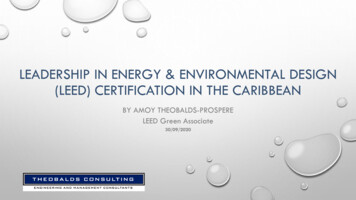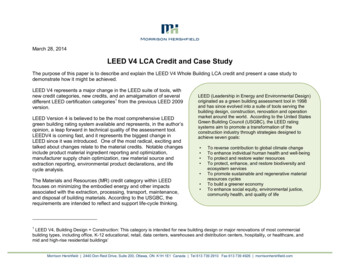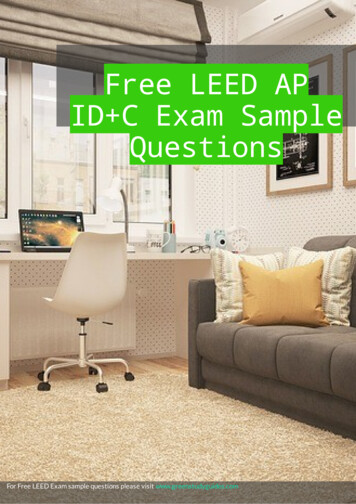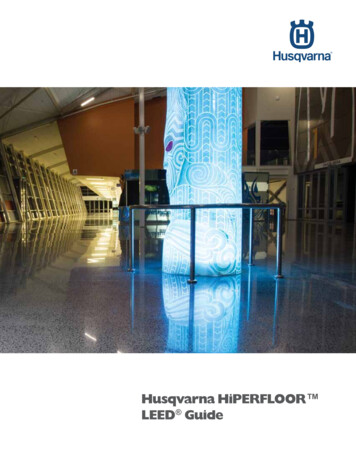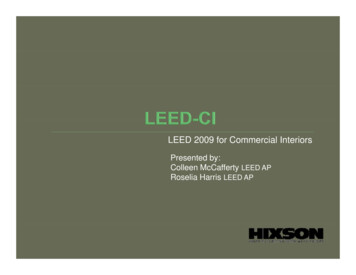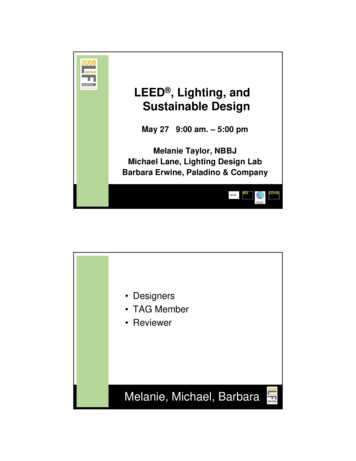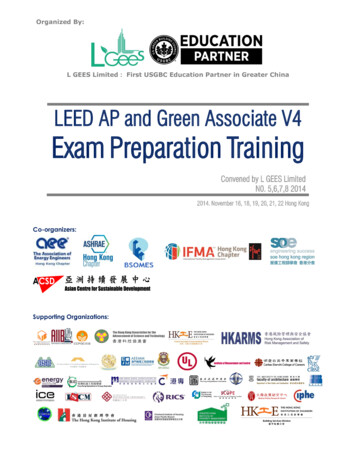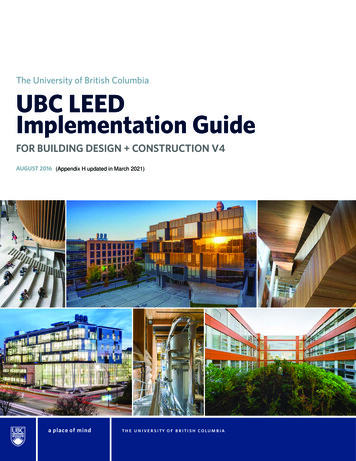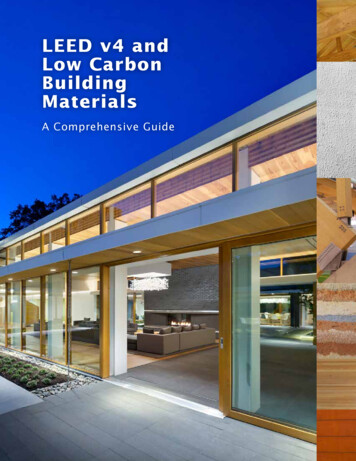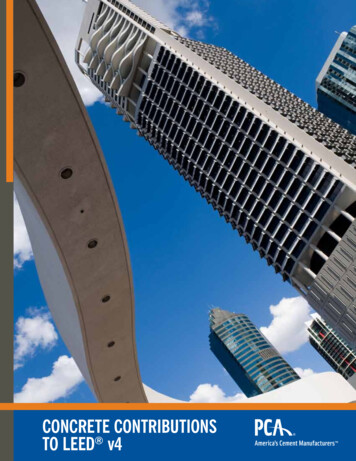
Transcription
Concrete Contributionsto LEED v4
In its continued goal to transform the marketplace,the U.S. Green Building Council (USGBC) developedits newest product, LEED v4, after an unprecedentedsix public comment periods and a vote of the fullcommittee membership in June 2013. LEED v4 includessix products, namely LEED for: Building Design and Construction Interior Design and Construction Existing Buildings: Operations and Maintenance Homes Neighborhood DevelopmentThe primary focus of this article is how concrete cancontribute to credits in LEED v4 for Building Design andConstruction (BD C), which includes New Construction,Core & Shell, Schools, Retail, Data Centers,Warehouses and Distribution Centers, Hospitality,and Healthcare. Requirements for complying withprerequisites and credits in LEED v4 are detailed in acomprehensive User’s Manual.1By focusing on the inherent properties of concrete, thisarticle highlights credits in LEED v4 to which concretemay contribute. Concrete’s characteristics of lowalbedo, thermal mass, recyclability, local availability,lack of volatile organic compounds (VOCs), and theindustry’s transparency can all contribute to moresustainable projects.1U.S. Green Building Council (USGBC). 2013. Reference Guide for Building Design andConstruction v4. ing-design-andconstructionLow AlbedoConcrete is an obvious material choice for reducing theurban heat island effect.Albedo, which in this context is synonymous with solarreflectance, is the ratio of the amount of solar radiationreflected from a material to the amount that shines onthe material. Solar radiation includes the ultraviolet aswell as the visible spectrum. Generally, light-coloredsurfaces have a high albedo, but this is not always thecase. Surfaces with lower albedos absorb more solarradiation. The absorbed radiation is converted into heatand the surface gets hotter. Where paved surfacesare required, using materials with higher albedos willreduce the heat island effect—consequently savingenergy by reducing the demand for air conditioning—and improve air quality. As the temperature of urbanareas increases, so does the probability of smogand pollution. Smog episodes rarely occur when thetemperature is below 21 C (70 F).Concrete constructed using ordinary portland cementgenerally has a reflectance of approximately 0.35,although it can vary. Measured values are reported inthe range of 0.35 to 0.5. For concrete made with whiteportland cement, values are reported in the range of0.7 to 0.8.SSc5: Heat Island ReductionIn LEED v4, this credit combines the LEED 2009 non-roofand roof credits for heat-island reduction. One strategyfor achieving credit in this category is to use materialswith an initial solar reflectance of 0.33. In LEED v4,this credit is only applicable to paving in the non-roofcategory, concrete without added pigments or coatingsPaved areas with light-colored surfaces reflect heat rather than absorb it, reducing the heat island effect and improving air quality.2
should be able to meet the requirement. Concretestested and reported by PCA2 all meet the initial(installation) requirement, including darker concretes.LTc5: Access to Quality TransitThis credit requires dedicated walking or bicycling lanesfrom school buildings to the end of the school property,in the direction of the transit lines. Although sidewalksno longer count toward SSc5 requirements for heatisland reduction, by using concrete for walking or bikelanes, an added benefit of reduction in the heat-islandeffect could be realized (though not eligible for creditthrough LEED).LTc6: Bicycle FacilitiesThis credit requires bicycle networks that connect theproject to various types of buildings. Although a bicyclenetwork can include streets with limited speed limits,it also includes bicycle paths and bicycle lanes. Likewith credit LTc5, if concrete is used for the bike paths,additional heat-island reduction on the site is possible(though not eligible for credit through LEED).Thermal MassConcrete has significant thermal mass. This meansconcrete components have enough heat-storagecapacity to moderate daily temperature swings.Buildings constructed of cast-in-place, tilt-up, or precastconcrete; insulating concrete forms (ICF); or masonrypossess thermal mass that helps moderate indoortemperature extremes and reduces peak heating andcooling loads.The thermal-mass advantages of concrete should beutilized when designing for passive thermal strategiesor minimizing energy use in a building. In many climates,these buildings have lower energy consumption thannon-massive buildings with walls of similar thermalresistance. When buildings are properly designed andoptimized, incorporating thermal mass can lead to areduction in heating, ventilating, and air-conditioningequipment capacity. Reduced equipment capacity canrepresent energy and construction cost savings. It isimportant when modeling energy performance of a2Marceau M.L., and VanGeem, M.G, Solar Reflectance for LEED Sustainable SitesCredit: Heat Island Effect, PCA Publication No. SN2982, Portland Cement Association,2007.3American Society of Heating, Refrigerating, and Air-Conditioning Engineers(ASHRAE). 2010. Energy Standard for Buildings Except Low-Rise Residential an Society of Heating, Refrigerating, and Air-Conditioning Engineers(ASHRAE). Advanced Energy Design Guides. ced-energy-design-guides5Concrete’s high capacity to store heat, called thermal mass, moderatestemperature swings and reduces the heating and cooling needs of buildings.building to take into account the thermal mass benefits.EAp2: Minimum Energy PerformanceIn this prerequisite, the general requirement is that newconstruction save 5% compared to ANSI/ASHRAE/IESNA Standard 90.1-2010, Energy Standard forBuildings Except Low-Rise Residential Buildings.3 Thiscan be demonstrated through whole building energysimulations (computer modeling) for Option 1, throughcompliance with ASHRAE Advanced Energy DesignGuides (AEDG) 4 for Option 2, or through compliancewith Advanced Buildings Core Performance Guide5 forOption 3.The requirements of the ASHRAE standard are costeffective and not particularly stringent for concrete.Insulating to meet or exceed the standard requirementsis generally a wise business choice. Determiningcompliance for the envelope components is relativelystraightforward using the tables in Appendix B of theASHRAE standard.EAc2: Optimize Energy PerformanceThis credit builds on EAp2 and specifies how manymore points can be achieved by saving more energy.This savings can be demonstrated through wholebuilding energy simulations (computer modeling) foradvancedbuildings.net/core-performance3
Local AvailabilityConcrete, and its constituent materials, are typicallysourced locally. For example, ready-mix and precastconcrete plants generally use aggregates that areextracted within 80 km (50 miles) of the plant. Cementand supplementary cementitious materials used forbuildings are also often manufactured within 800 km(500 miles) of a job site. Reinforcing steel is usuallymanufactured within 800 km (500 miles) of a job site,and is typically made from recycled materials from thesame region. This aids in value calculations for Materialand Resource credits in LEED v4.Concrete is frequently crushed and recycled into aggregate for road basesor construction fill.Option 1, for up to 18 points; or through compliancewith ASHRAE Advanced Energy Design Guides (AEDG)for Option 2, for up to 6 points. As mentioned inEAp2, meeting or exceeding the requirements of theASHRAE standard are cost-effective and not particularlystringent for concrete.RecyclableConcrete is a relatively heavy construction material, yetis frequently crushed and recycled into aggregate forroad bases or construction fill. This assists in the LEEDv4 credits related to construction waste.MRp2: Construction and demolition wastemanagement planningMRc3: Building Product Disclosure and Optimization—Sourcing of Raw MaterialsThis credit has changed significantly since the lastversion of LEED. The intent of this credit is: “Toencourage the use of products and materials forwhich life cycle information is available and that haveenvironmentally, economically, and socially preferablelife cycle impacts. To reward project teams forselecting products verified to have been extractedor sourced in a responsible manner.” Two optionsare available: Raw Material Source and ExtractionReporting, and Leadership Extraction Practices.The first method of compliance (Raw Material Sourceand Extraction Reporting) is to use 20 permanentlyinstalled products—sourced from at least 5 differentmanufacturers—that have a publicly released reportfrom suppliers including:This is a new prerequisite in LEED v4 for planningconstruction, renovation, and demolition waste. Nothresholds are set, yet a waste management planmust be created. Concrete waste is minimal in newconstruction and can be recycled in most urban areas.MRc5: Construction and Demolition WasteManagementThis credit encourages diversion of construction wastefrom landfills and incineration. Calculations are stilldone by weight or volume. Two options are available forearning points in this credit.In Option 1, the possible points depend on whether 50%of the total construction and demolition waste is divertedfrom three material streams (1 point), or 75% of the totalconstruction and demolition waste is diverted from fourmaterial streams (2 points). For Option 2, a project canearn 2 points if less than 2.5 lb of construction wasteis generated per square foot of building floor area. Nomatter the option chosen by the project team, concretecan contribute because waste is minimal, and whateverwaste is generated is recyclable in most areas.4 Raw material supplier extraction locations, A commitment to long-term ecologicallyresponsible land use, A commitment to reducing environmental harmsfrom extraction and/or manufacturing processes,and A commitment to meeting applicable standardsor programs voluntarily that address responsiblesourcing criteria.If manufacturers provide self-declared reports forOption 1, products are valued at ½ of a product.Manufacturers that have third-party verified corporatesustainability reports (CSR), conforming to one of thefollowing frameworks, are valued at 1 whole product.6 Global Reporting Initiative (GRI) SustainabilityReport6 Organisation for Economic Co-operation andglobalreporting.org/
based on source location as such: Products sourced within 100 miles of project siteare valued at 200% of their cost. Products sourced domestically within 500 milesof project site are valued at 150% of their cost.As mentioned previously, concrete and its constituentsare typically sourced very close to the project site andcan add to the material valuation of this credit.Low or No VOCsConcrete and its components are typically sourced locally, often within 50miles, and constructed with local labor.Development (OECD) Guidelines for MultinationalEnterprises7 U.N. Global Compact: Communication ofProgress8 ISO 26000: 2010 Guidance on SocialResponsibility9 USGBC approved programFor Option 2, Leadership Extraction Practices, 25%of the total value of permanently installed buildingproducts must meet at least one of the followingcriteria: Bio-based according to the SustainableAgriculture Network’s Sustainable AgricultureStandard New wood certified by FSC or USGBC-approvedequivalent Reused materials Recycled content, which is still calculated aspostconsumer content plus ½ preconsumercontent USGBC-approved programConcrete typically uses supplementary cementitiousmaterials, such as fly ash, silica fume, and slag cement,which are considered post-industrial recycled content.Concrete contains low to negligible volatile organiccompounds (VOCs). These compounds degrade indoorair quality when they off-gas from new products. Inaddition, VOCs combine with other chemicals in the airto form ground-level ozone. Complaints due to poorindoor air quality routinely include eye, nose, and throatirritation; dryness of the mucous membranes and skin;nose bleeds; skin rash; mental fatigue and headache;cough; hoarseness; wheezing; nausea; dizziness; andincreased incidence of asthma.EQc2: Low-Emitting MaterialsThis credit contains a statement that plain concreteis inherently non-emitting and VOC emission testingis not required. The text states: “Products that areinherently non-emitting sources of VOCs – specificallystone, ceramics, powder-coated metals, plated metalsor anodized metals, glass, concrete, clay brick,and unfinished/untreated solid wood flooring – areconsidered fully compliant without any VOC emissionstesting if they do not include integral organic-basedsurface coatings, binders, or sealants.”For Healthcare and Schools projects, LEED has this newrequirement for exterior10 applied products: “Adhesives,sealants, coatings, roofing and waterproofing materialsapplied on-site shall meet the VOC limits of CaliforniaAir Resources Board (CARB) 2007 Suggested ControlMeasure (SCM) for Architectural Coatings and SouthCoast Air Quality Management District (SCAQMD) Rule1168 effective July 1, 2005. The provisions of thissection shall not apply to small containers of adhesivesand sealants subject to state or federal consumerproduct VOC regulations.”11 There are sealants andcoatings that are applied to the exterior surface ofconcrete and masonry that meet this requirement.For the purpose of calculations, products are rg/cop/9 l10The building exterior is defined as everything outside and inclusive of the primary andsecondary weatherproofing system, including waterproofing membranes and air andwater resistive barrier materials.11http://aqmd.gov/rules/download.html5
new focus on reuse. The durability of concrete cancontribute to the three credits related to reuse.For new construction, Option 4 in MRc1 requiresthat a whole building life-cycle assessment (LCA) beperformed. The concrete industry has been providinglife-cycle data since the early 2000s. There isrelevant cement and concrete LCI data in the U.S. LCIdatabase.12To achieve points with this option, a minimumof 10% reduction in at least three of six impactcategories compared to a reference building must bedemonstrated. A whole-building LCA must be performedon the structure and enclosure of a reference buildingand on that of the proposed project building. The LCAmust conform to ISO 14044,13 and a minimum servicelife of 60 years must be modeled.The 10% reduction must be shown in global warmingpotential (in kg CO2e) and two of the following fiveimpact categories for 3 points:Because of its mass, concrete provides an effective buffer to reduce noisefrom the outside or from neighboring rooms.Resistance to NoiseBecause of its mass, concrete provides a buffer betweenoutdoor noise and the indoor environment. Concrete canreduce the amount of sound that can move through awall. An 8-in.-thick (200 mm) flat wall panel has a soundtransmission coefficient (STC) of 58 and outdoor-indoortransmission class (OITC) of 50. For floors, an 8-in.-thickhollow-core with a carpet and pad has an STC of 50 withan impact insulation class (IIC) of 73.EQc9: Acoustical PerformanceThis credit requires minimum composite STC ratingsfor adjacent spaces. The requirement states, “meetthe composite sound transmission class (STCC) ratingslisted in Table 1, or local building code, whichever ismore stringent.” The requirements in the table are muchmore stringent than national building codes. However,higher STC ratings are often achieved more-easily whenusing concrete.Embraces TransparencyThe cement and concrete industry has embracedenvironmental transparency for some time, publishingits first industry-average LCA in 2000.MRc1: Building life-cycle impact reductionThis credit has 4 options; three of these are for reuseand up to five points are available reflecting USGBC’s6 Depletion of the stratospheric ozone layer in kgCFC-11 Acidification of land and water sources in molesH or kg SO2 Eutrophication in kg N or kg Phosphate Formation of tropospheric ozone in kg NOx or kgEthene Depletion of non-renewable energy resources inMJMRc2: Building Product Disclosure andOptimization—Environmental Product DeclarationsThe intent of this credit is “To encourage the useof products and materials for which life-cycleinformation is available and that have environmentally,economically, and socially preferable life-cycle impacts.To reward project teams for selecting productsfrom manufacturers who have verified improvedenvironmental life-cycle impacts.”Two options are available: environmental productdeclaration (EPD) and multi-attribute optimization. Theconcrete industry developed a product category rule(PCR) for ready-mixed concrete in 2012,14 and concretemanufacturers are in the process of developing EPDsfor their products. The cement industry, and several12www.nrel.gov/lci/13 www.iso.org/iso/home/store/catalogue tc/catalogue detail.htm?csnumber 3849813www.nrel.gov/lci/13 www.iso.org/iso/home/store/catalogue tc/catalogue detail.htm?csnumber 38498
Reduced environmental impact (per USGBCprogram).The extended producer responsibility alternativevalues products at 50% of their cost. USGBC-approvedprograms for the reduced environment impactalternative of Option 2 are currently listed as thosecertification programs that verify impact reduction(below industry average) of products in three of thefollowing categories:Concrete’s durability opens up opportunities for reuse and reduces theenvironmental impact of a building over its life-cycle.other concrete-related industries, are currentlydeveloping PCRs for North American use as well.In the first method of compliance, the project teammust use 20 permanently installed products—sourcedfrom at least 5 different manufacturers—that: Have a product-specific declaration, Have an industry-wide (generic) EPD, Have a product-specific Type III EPD, or Conform to a USGBC-approved program.It is possible that the credit could be interpreted suchthat the many products that comprise a concreteor masonry assembly could count toward the 20permanently installed products. For instance, thecementitious materials, aggregate, and sealants wouldlikely all count as separate products.For the purpose of calculations, products are valuedbased on the stringency of the declaration as such: Products with a product-specific declaration arevalued at ¼ of a product Products with an industry-wide (generic) EPD arevalued at ½ of a product Products with a product-specific Type III EPD arevalued as a whole productFor Option 2, 50% of the value of permanently installedproducts (by cost) must have: 14Extended producer responsibility, orwww.carbonleadershipforum.org/Carbon Leadership fourm/PCR.htmlww.nrel.gov/lci/13 www.iso.org/iso/home/store/catalogue tc/catalogue detail.htm?csnumber 38498 global warming potential, depletion of stratospheric ozone, acidification, eutrophication, formation of tropospheric ozone, or depletion of nonrenewable energy sources.Products used to meet the criteria are also valuedaccording to source. Values are: Products sourced within 100 miles of the projectsite are valued at 200% of their cost. Products sourced domestically within 500 miles ofthe project site are valued at 150% of their cost.These distances are generally easily achieved forconcrete products.MRc4: Building product disclosure andoptimization—material ingredientsThe intent of this credit is to address human toxicity– an impact that is not addressed in the LEED v4LCA requirements. The intent of the credit reads:“To encourage the use of products and materials forwhich life-cycle information is available and that haveenvironmentally, economically, and socially preferablelife-cycle impacts. To reward project teams for selectingproducts for which the chemical ingredients in theproduct are inventoried using an accepted methodologyand for selecting products verified to minimize the useand generation of harmful substances.” There are threeoptions for this credit: Material Ingredient Reporting,and Material Ingredient Optimization, and Supply ChainOptimization.The (Material Ingredient Reporting) option requires theuse 20 permanently installed products—sourced fromat least 5 different manufacturers—that comply withany of the following chemical-inventory programs: Manufacturer Inventory – basically an inventoryof all ingredients,7
Health Product Declaration (HPD) – productmust have and HPD with full disclosure of knownhazards in compliance with the HPD Collaborativestandard,15 Cradle to Cradle – product must be certified tothe Cradle to Crade v2 Basic Level of the Cradleto Cradle v3 Bronze Level,16 or USGBC-approved program.Products must have chemicals inventoried to 1000ppm.USGBC approved program, GreenScreen v1.2 Benchmark – product musthave fully inventoried chemical ingredients to 100ppm that have no Benchmark 1 certified.org/product /18c2ccertified.org/product ssionid 708167B5EE5BFA01D7B314128B9CE43B.live18 International Alternative Compliance Path –REACH Optimization – product cannot containsubstance that meet REACH criteria forsubstances of very high concern.19 who engage in validated and robust safety,health, hazard and risk programs, and with independent third party verification.These are new requirements for the cement andconcrete industries, but producers intend to workwith architects and engineers to meet these newrequirements in LEED v4.PCA is a member of the United States Green Building Council15Cradle to Cradle Certified – product is valuedbased on the version and certification level of thevarious Cradle to Cradle programs,18 orThe Supply Chain Optimization option requires 25% ofthe value of permanently installed products (by cost)must be from product manufactures:For Option 2 (Material Ingredient Optimization), 25% ofthe value of permanently installed products (by cost)must use one of the following to comply:
the U.S. Green Building Council (USGBC) developed its newest product, LEED v4, after an unprecedented six public comment periods and a vote of the full committee membership in June 2013. LEED v4 includes six products, namely LEED for: Building Design and Construction Interior
